Getting into the mind of a character is one of the greatest parts of reading, whether you’re finding a new one or rediscovering an old favorite. From a dinosaur who’s on a quest to improve his hug to a 13-year-old elephant driver who lives on the edge of the jungle in the borderlands of 1970s Nepal, the books in this week’s column introduce readers to compelling characters having exciting experiences in interesting places.
Ages 4–8
Carl and the Meaning of Life. Deborah Freedman. 2019. Viking/Penguin.
 After a field mouse asks why he tunnels underground day after day, Carl the earthworm realizes he doesn’t know why. He asks a rabbit, fox, and squirrel, “Why do I do what I do?” but none has a satisfying answer for him although they know why they do what they do. However, when a ground beetle laments that he can’t find any grubs, Carl discovers the dirt has turned hard as rock. He finally has his answer and gets busy turning the hard dirt back into fluffy, fertile soil, which sprouts seeds for the mouse who asked him the question in the first place and triggers a chain of events that benefits everyone. Freedman’s colorful mixed-media illustrations add depth to her engaging story with an important child-friendly message. The author’s note “Everything is connected” along with a challenge for readers to identify how they help the earth and a relevant quote from Charles Darwin about the important role of the earthworm in our world.
After a field mouse asks why he tunnels underground day after day, Carl the earthworm realizes he doesn’t know why. He asks a rabbit, fox, and squirrel, “Why do I do what I do?” but none has a satisfying answer for him although they know why they do what they do. However, when a ground beetle laments that he can’t find any grubs, Carl discovers the dirt has turned hard as rock. He finally has his answer and gets busy turning the hard dirt back into fluffy, fertile soil, which sprouts seeds for the mouse who asked him the question in the first place and triggers a chain of events that benefits everyone. Freedman’s colorful mixed-media illustrations add depth to her engaging story with an important child-friendly message. The author’s note “Everything is connected” along with a challenge for readers to identify how they help the earth and a relevant quote from Charles Darwin about the important role of the earthworm in our world.
—NB
Cyril and Pat. Emily Gravett. 2019. Simon & Schuster.
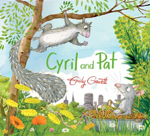 Cyril, the only squirrel in Lake Park, is lonely until he meets Pat. Cyril happily shouts that his new friend is a big gray squirrel, but Pat is actually a rat. The other animals try to point out his error. “Oh, Cyril, can’t you see that your friend Pat / is not like you. Your friend’s a . . .” but before they can say rat, Cyril jumps in with “Real joker!” or “Brilliant sharer!” or “CLEVER SQUIRREL.” After Pat’s true identity is revealed by a young boy and all the animals reinforce that squirrels can’t be friends with rats, Cyril is sad—until a scary misadventure leaves him recognizing that two individuals can be friends in spite of differences. Follow the reading of Kate Greenaway Medalist Emily Gravett’s colorful rhyming picture book by introducing young children to some of her other delightful stories about interesting animal characters.
Cyril, the only squirrel in Lake Park, is lonely until he meets Pat. Cyril happily shouts that his new friend is a big gray squirrel, but Pat is actually a rat. The other animals try to point out his error. “Oh, Cyril, can’t you see that your friend Pat / is not like you. Your friend’s a . . .” but before they can say rat, Cyril jumps in with “Real joker!” or “Brilliant sharer!” or “CLEVER SQUIRREL.” After Pat’s true identity is revealed by a young boy and all the animals reinforce that squirrels can’t be friends with rats, Cyril is sad—until a scary misadventure leaves him recognizing that two individuals can be friends in spite of differences. Follow the reading of Kate Greenaway Medalist Emily Gravett’s colorful rhyming picture book by introducing young children to some of her other delightful stories about interesting animal characters.
—CA
Fear the Bunny. Richard T. Morris. Ill. Priscilla Burris. 2019. Caitlyn Dlouhy/Atheneum/Simon & Schuster.
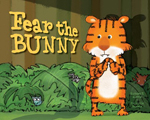 “Bunnies, bunnies, burning bright, in the forest of the night—.” When Tiger comes across a hedgehog reading an altered version of William Blake’s “The Tyger” to a group of animals, he attempts a correction. “The poem is about . . . ME! The most feared animal in the forest.” Insisting that in their forest they fear bunnies, the animals hide as a bunny approaches in the dark, and Tiger pokes fun at their fright—until he pursued by a stampede of bunnies. In the final double-page spread, Tiger is shown reading “Bunnies, bunnies, burning bright . . .” to a gathering of animals including two tigers. Pricilla Burris’ mixed-media illustrations featuring Tiger and a host of cute animals against a dark forest background make this a good scary-but-not-too-scary read aloud. Blake’s “The Tyger” is included on the back endpaper.
“Bunnies, bunnies, burning bright, in the forest of the night—.” When Tiger comes across a hedgehog reading an altered version of William Blake’s “The Tyger” to a group of animals, he attempts a correction. “The poem is about . . . ME! The most feared animal in the forest.” Insisting that in their forest they fear bunnies, the animals hide as a bunny approaches in the dark, and Tiger pokes fun at their fright—until he pursued by a stampede of bunnies. In the final double-page spread, Tiger is shown reading “Bunnies, bunnies, burning bright . . .” to a gathering of animals including two tigers. Pricilla Burris’ mixed-media illustrations featuring Tiger and a host of cute animals against a dark forest background make this a good scary-but-not-too-scary read aloud. Blake’s “The Tyger” is included on the back endpaper.
—CA
Tiny T. Rex and the Impossible Hug. Jonathan Stutzman. Ill. Jay Fleck. 2019. Chronicle.
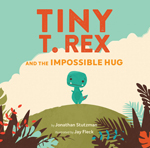 Tiny T. Rex tries to cheer up his sad pal Pointy with a hug but can’t wrap his short, stubby arms around his large dinosaur friend. After asking for advice from his father, aunt, and mother, whose responses are not helpful (“mathematics might be the answer,” “balance and freshly squeezed cucumber juice,” and “it’s okay if you can’t hug”), his siblings suggest that he practice. A lot. Hugging a purple tree trunk that turns out to be the leg of a dinosaur that flies through the air with him clinging to it, Tiny lets go and plops right down onto the head of his friend Pointy, who exclaims, “That was the biggest hug ever.” Bright, digitally colored pencil illustrations demonstrate size comparisons nicely as Tiny learns not to give up because tiny hugs come from big hearts.
Tiny T. Rex tries to cheer up his sad pal Pointy with a hug but can’t wrap his short, stubby arms around his large dinosaur friend. After asking for advice from his father, aunt, and mother, whose responses are not helpful (“mathematics might be the answer,” “balance and freshly squeezed cucumber juice,” and “it’s okay if you can’t hug”), his siblings suggest that he practice. A lot. Hugging a purple tree trunk that turns out to be the leg of a dinosaur that flies through the air with him clinging to it, Tiny lets go and plops right down onto the head of his friend Pointy, who exclaims, “That was the biggest hug ever.” Bright, digitally colored pencil illustrations demonstrate size comparisons nicely as Tiny learns not to give up because tiny hugs come from big hearts.
—NB
Ages 9–11
Freya & Zoose. Emily Butler. Ill. Jennifer Thermes. 2019. Crown/Penguin.
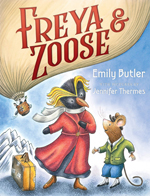 Inspired by Hints to Lady Travellers at Home and Abroad, a guidebook for Victorian adventurers, Freya, a Scandinavian rockhopper penguin, stows away on Captain Salomon August Andrée’s hot air balloon expedition to the North Pole. Once aloft she discovers that there is another stowaway, a cocky, ill-mannered London-born mouse named Zoose, who wants to become famous as the first mouse to explore the North Pole. When the ill-fated expedition is forced to land in the Arctic, Freya and Zoose must learn how to work together if they are to survive. Jennifer Thermes’ black-and-white drawings extend the humor of Emily Butler’s captivating animal fantasy. In an author’s note, Butler provides background information about Captain Andrée, Nils Strindberg, and Knut Faenkels, who attempted the flight by hot-air balloon to the North Pole in 1897 and perished; rockhopper penguins; the Artic region; and Lillias Campbell Davidson, the author of Hints to Lady Travellers.
Inspired by Hints to Lady Travellers at Home and Abroad, a guidebook for Victorian adventurers, Freya, a Scandinavian rockhopper penguin, stows away on Captain Salomon August Andrée’s hot air balloon expedition to the North Pole. Once aloft she discovers that there is another stowaway, a cocky, ill-mannered London-born mouse named Zoose, who wants to become famous as the first mouse to explore the North Pole. When the ill-fated expedition is forced to land in the Arctic, Freya and Zoose must learn how to work together if they are to survive. Jennifer Thermes’ black-and-white drawings extend the humor of Emily Butler’s captivating animal fantasy. In an author’s note, Butler provides background information about Captain Andrée, Nils Strindberg, and Knut Faenkels, who attempted the flight by hot-air balloon to the North Pole in 1897 and perished; rockhopper penguins; the Artic region; and Lillias Campbell Davidson, the author of Hints to Lady Travellers.
—CA
Mr. Penguin and the Lost Treasure. Alex T. Smith. 2019. Peachtree.
 Having placed an ad in the newspaper offering his services, Mr. Penguin is eagerly awaiting his first adventure as a Professional Adventurer, and it comes with a call from Boudicca Bones, owner of the Museum of Extraordinary Objects. To save the very old museum in need of restoration, she and her brother are desperate to locate the treasure buried by their great-great-great-grandfather somewhere in the museum. With his sidekick, a resourceful spider named Colin, Mr. Penguin rushes to the museum and soon discovers that the job is going to be more difficult, more dangerous, and definitely more adventurous than he anticipated. Will he find the lost treasure? How will he survive his first proper Adventuring job? Readers who enjoy this humorous action-packed tale will be eager to join Mr. Penguin on another exciting Adventure.
Having placed an ad in the newspaper offering his services, Mr. Penguin is eagerly awaiting his first adventure as a Professional Adventurer, and it comes with a call from Boudicca Bones, owner of the Museum of Extraordinary Objects. To save the very old museum in need of restoration, she and her brother are desperate to locate the treasure buried by their great-great-great-grandfather somewhere in the museum. With his sidekick, a resourceful spider named Colin, Mr. Penguin rushes to the museum and soon discovers that the job is going to be more difficult, more dangerous, and definitely more adventurous than he anticipated. Will he find the lost treasure? How will he survive his first proper Adventuring job? Readers who enjoy this humorous action-packed tale will be eager to join Mr. Penguin on another exciting Adventure.
—CA
Rabbit’s Bad Habits (Rabbit & Bear #1). Julian Gough. Ill. Jim Field. 2019. Silver Dolphin/Printers Row.
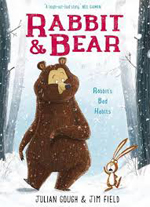 Bear awakens mid-hibernation to find her store of food (honey, salmon, and beetles’ eggs) gone. While building a snowman, she accidentally rolls a big ball of snow over the entrance to a rabbit’s hole and encounters grumpy and unfriendly Rabbit. Rejecting kind and friendly Bear’s invitation to help build a snowman, Rabbit decides to make an even better snowman, but first, for energy he eats lots and lots of honey, salmon, and beetle’s eggs. “Then he did a little poo, and ate it.” (Yes, rabbits do that, as Rabbit explains in a funny and informative sequence.) After Bear saves Rabbit from pursuit by a hungry Wolf with a well-tossed snowball “as big as an avalanche, and as fast as a train,” they enjoy a celebratory winter picnic of honey, salmon, and beetle’s eggs and go to sleep in the cave. This series opener with a giggle-inducing text and illustrations on every page is perfect for newly independent readers.
Bear awakens mid-hibernation to find her store of food (honey, salmon, and beetles’ eggs) gone. While building a snowman, she accidentally rolls a big ball of snow over the entrance to a rabbit’s hole and encounters grumpy and unfriendly Rabbit. Rejecting kind and friendly Bear’s invitation to help build a snowman, Rabbit decides to make an even better snowman, but first, for energy he eats lots and lots of honey, salmon, and beetle’s eggs. “Then he did a little poo, and ate it.” (Yes, rabbits do that, as Rabbit explains in a funny and informative sequence.) After Bear saves Rabbit from pursuit by a hungry Wolf with a well-tossed snowball “as big as an avalanche, and as fast as a train,” they enjoy a celebratory winter picnic of honey, salmon, and beetle’s eggs and go to sleep in the cave. This series opener with a giggle-inducing text and illustrations on every page is perfect for newly independent readers.
—CA
Straw into Gold: Fairy Tales Re-spun. Hilary McKay. Ill. Sarah Gibb. 2019. Margaret K. McElderry/Simon & Schuster.
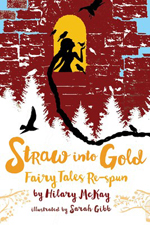 Hilary McKay spins different perspectives into her retellings of the ten traditional fairy tales in this collection: “Rapunzel,” “Cinderella,” “The Princess and the Pea,” “Rumpelstiltskin,” “The Pied Piper of Hamelin,” “The Swan Brothers,” “Snow White and the Seven Dwarves,” “Red Riding Hood,” “The Twelve Dancing Princesses,” and “Hansel and Gretel.” In “Straw into Gold,” Petal, the miller’s daughter, manipulates Rumpelstiltskin, a hob who yearns for a child, into spinning a barnful of barley straw into gold thread (so the King will marry her) in exchange for her first child, and then tricks him with a guessing game about his name to go back on her promise. In a twist at the end, after Petal’s death, her son delivers an apology from her to Rumpelstiltskin, and they enjoy time together. Sarah Gibb’s black-and-white, delicately detailed painted scenes and silhouettes are exquisite additions to these “re-spun” tales. A bibliography is included.
Hilary McKay spins different perspectives into her retellings of the ten traditional fairy tales in this collection: “Rapunzel,” “Cinderella,” “The Princess and the Pea,” “Rumpelstiltskin,” “The Pied Piper of Hamelin,” “The Swan Brothers,” “Snow White and the Seven Dwarves,” “Red Riding Hood,” “The Twelve Dancing Princesses,” and “Hansel and Gretel.” In “Straw into Gold,” Petal, the miller’s daughter, manipulates Rumpelstiltskin, a hob who yearns for a child, into spinning a barnful of barley straw into gold thread (so the King will marry her) in exchange for her first child, and then tricks him with a guessing game about his name to go back on her promise. In a twist at the end, after Petal’s death, her son delivers an apology from her to Rumpelstiltskin, and they enjoy time together. Sarah Gibb’s black-and-white, delicately detailed painted scenes and silhouettes are exquisite additions to these “re-spun” tales. A bibliography is included.
—NB
Ages 12–14
A Circle of Elephants. Eric Dinerstein. 2019. Disney-Hyperion.
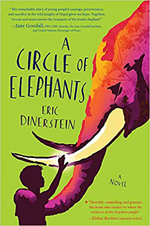 Thirteen-year-old Nandu works for the head of the king of Nepal’s elephant stable as an elephant driver at the Royal Elephant Breeding Center in the borderlands between Nepal and India. As Nandu protects his “elephant brother” (Hira Prasad, a powerful bull elephant) as well as other elephants and endangered animals from danger in nature (drought, earthquakes, predators) and man (poachers and corrupt government officials), help comes from old and new friends and allies, and he learns that “we are all connected and stronger together than apart.” Back matter includes a glossary and an informative author’s note from conservationist Eric Dinerstein. Readers interested in the backstory of Nandu’s abandonment in the jungle 10 years earlier will want to read the earlier companion book, What Elephants Know (2016).
Thirteen-year-old Nandu works for the head of the king of Nepal’s elephant stable as an elephant driver at the Royal Elephant Breeding Center in the borderlands between Nepal and India. As Nandu protects his “elephant brother” (Hira Prasad, a powerful bull elephant) as well as other elephants and endangered animals from danger in nature (drought, earthquakes, predators) and man (poachers and corrupt government officials), help comes from old and new friends and allies, and he learns that “we are all connected and stronger together than apart.” Back matter includes a glossary and an informative author’s note from conservationist Eric Dinerstein. Readers interested in the backstory of Nandu’s abandonment in the jungle 10 years earlier will want to read the earlier companion book, What Elephants Know (2016).
—NB
Ages 15+
Lovely War. Julie Berry. 2019. Viking/Penguin.
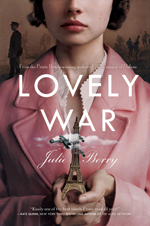 On the eve of World War II in a New York hotel, Aphrodite (goddess of love) and her brother-in-law Ares (god of war) are caught in the act of adultery by her husband, Hephaestus (god of fire and forges), who agrees to preside over their private trial as judge, jury, and executioner. Presented in the format of a court trial, complete with witnesses, Aphrodite offers her orchestrationof the love stories of two mortal couples (Hazel, a classical pianist from London, and James, a British soldier with dreams of becoming an architect; and Aubrey, a Harlem jazz pianist in the U.S. Army, and Colette, a Belgium orphan and singer) from the World War I era. Pronouncing acquittal, Hephaestus realizes that not only has Aphrodite demonstrated the transcendent power of love, she also identified him as the only one capable of loving her before sealing the deal with a “kiss for the ages.”
On the eve of World War II in a New York hotel, Aphrodite (goddess of love) and her brother-in-law Ares (god of war) are caught in the act of adultery by her husband, Hephaestus (god of fire and forges), who agrees to preside over their private trial as judge, jury, and executioner. Presented in the format of a court trial, complete with witnesses, Aphrodite offers her orchestrationof the love stories of two mortal couples (Hazel, a classical pianist from London, and James, a British soldier with dreams of becoming an architect; and Aubrey, a Harlem jazz pianist in the U.S. Army, and Colette, a Belgium orphan and singer) from the World War I era. Pronouncing acquittal, Hephaestus realizes that not only has Aphrodite demonstrated the transcendent power of love, she also identified him as the only one capable of loving her before sealing the deal with a “kiss for the ages.”
—NB
Nancy Brashear is Professor Emeritus of English, Azusa Pacific University, in Azusa, California. Carolyn Angus is former director of the George G. Stone Center for Children's Books, Claremont Graduate University, in Claremont, California.
These reviews are submitted by members of the International Literacy Association's Children's Literature and Reading Special Interest Group (CL/R SIG) and are published weekly on Literacy Daily.